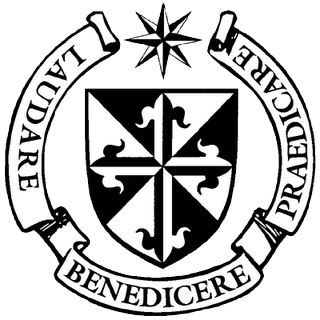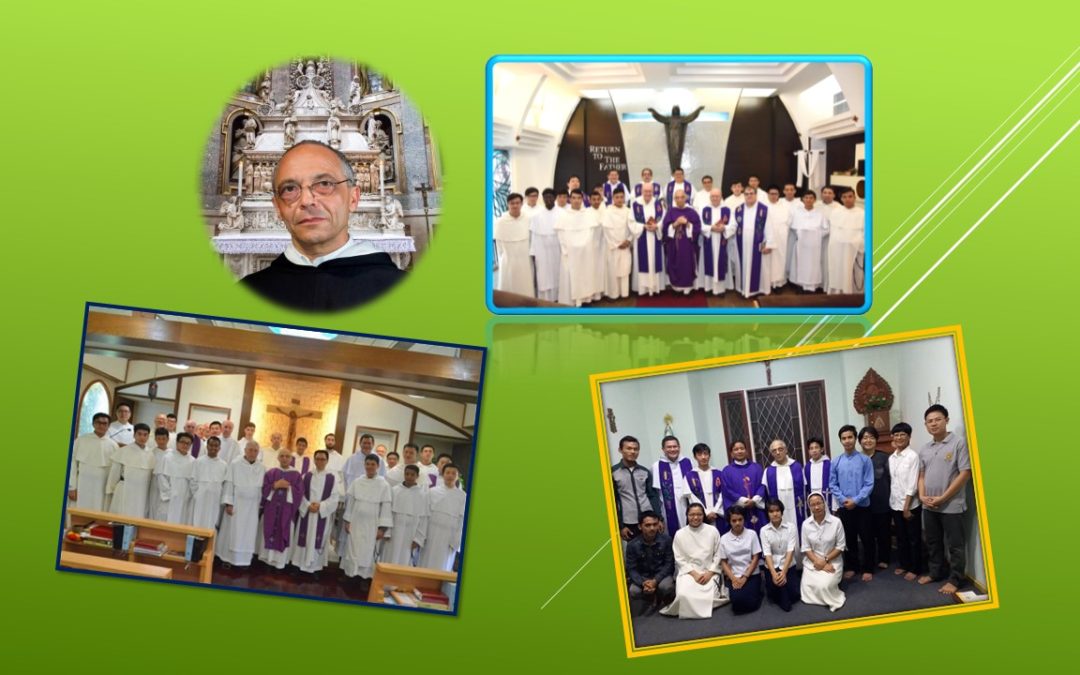
(This article is taken from the web-page of the Order of Preachers: http://www.op.org/en)
The Master of the Order Father Bruno Cadoré, and his Socius for Asia-Pacific Fr. Gerald Francis Timoner, visited the friars of Our Lady of the Rosary Province that that are working in the missions of Myanmar, Timor Leste, Singapore, Hong Kong and Macau during the period of 27 March to 7 April 2017.
They started the visit in Myanmar and they visited the brothers that are working in the areas of Loikaw, Mandalay and Yangon. They appreciated the new developments done during the last four years with the building of the new church in the parish of St. Gemma Galgani in Yangon and the new chapel and churches in the house of St. Thomas Aquinas in Nawalawo Village   in Loikaw, Kayah State. In Mandalay they visited the social centre and educational supplementary centre of St. Martin de Porres where special supplementary education is given to about 150 high school children. The last stage was the House of St. Dominic of Yangon where they talked with the pre-novices and in the company of the three Fathers visited the parish of St. Gemma Galgani.
From Yangon they flight to Dili, Timor Leste. They travelled by car to Hatudo to visit the mission, the church and the schools of the mission. They returned to Dili and had a meeting with the Fathers, with the aspirants and with the Dominican Family working in Timor Leste.
And from Dili they flight to Hong Kong with stopover in Singapore where they visited the two Fathers working in the House of St. Francis Capillas. They took a late flight for Hong Kong that landed in Hong Kong’s airport at midnight and they arrived at St. Albert’ Priory in the early hours of 5 April. They joined the community in the morning prayers and mass and after breakfast, Father Bruno Cadoré started talking with different groups of brothers in formation. Master Bruno Cadoré held talks with the Chinese student brothers, with the Chinese priests and deacons and with all the Chinese priests working in the mission of China. After lunch, Master Bruno Cadoré held a meeting with the group of novices.
At 5:00 pm Fr. Bruno Cadoré and Fr. Gerard Francisco Timoner left for Macau to conduct de second canonical visitation to the Studentate. Fr. Provincial accompanied them arriving in the evening to have dinner with the community and they held a group meeting with the student brothers. On the morning of April 6, Fr. Bruno presided and preached at the Conventual Mass. They left for Hong Kong after having breakfast with the community.
Back in Hong Kong and after lunch at St. Albert Priory, Fr. Bruno and Fr. Gerard Francisco Timoner held a fruitful meeting with the Formation Council of the Province. Â Later on in the late afternoon, they went to the Provincial House of St. Joseph in Kowloon to meet the postulants and have dinner with the community. They came back to St. Albert Priory and in the morning of 7 April, Fr. Bruno presided and preached at the Conventual Mass. After the mass there was time to have a historical photo with all the members of the community of St. Albert.
After breakfast, Fr. Bruno met first Fr. Provincial. Afterwards Fr. Bruno and Fr. Gerald held a working meeting with the Provincial Council and the representatives of the missions of the Province in Hong Kong and Macau, Manila, Taiwan and Japan. After the meeting it was time for lunch and friendly sharing with the community. In the midafternoon Fr. Bruno and Fr. Gerard left for the airport and took the plane back to Rome.
(3 May 2017)

FAUSTO GOMEZ OP
faustogomezb@yahoo.com
    San Domingos Church in Macau is one of the favorite places for tourists and in particular for Christians and believers. The original structure of the Church was built upon orders of the first three Spanish Dominican missionaries, who had arrived here about September 1, 1587. The main altar of the baroque Church is presided by a royal statue of Our Lady of the Rosary accompanied on her right side by a statue of St. Dominic de Guzman (San Domingos), the founder of the Order of Preachers or Dominicans, and on her left side by a statue of St. Catherine of Siena. The great Italian mystic and Dominican saint is one of the patrons of the Diocese of Macau, and her feast is celebrated on April 29 of every year.
    Catherine Benincasa was born on March 25, 1347 in Siena, Italy. Jacobo and Lapa, her parents, had twenty five children. Catherine was their twenty third child. She was a deeply pious girl. When she was about seventeen years old, Catherine joined the “Mantellata†of Siena – a group of lay women of the Third Order of Penance of Saint Dominic. She died on April 29, 1380 – after much suffering. She was canonized by Pius II in 1461, proclaimed a co-patron of Europe by Pope Pius XII in 1939, and declared Doctor of the Church by Pope Paul VI in 1970.
    Catherine wrote a major work of spiritual and mystical life: the Dialogue, or the Book of Divine Providence, which is a conversation between God and Catherine. As it has been said, more than a book it is Catherine’s life. She also wrote hundreds of wonderful moving letters and about twenty six prayers uttered by her during periods of ecstasies or while praying aloud; the prayers were taken down by her followers.
    The point of departure of St. Catherine’ spiritual life is knowledge of God and self-knowledge. God tells her: “From knowledge of me to knowledge of self, and from love of me to love of others.†For Catherine, God is the Supreme Truth, “gentle first Truth,†and the Supreme Love, “Love itself.†God asks her: “Do you know, my daughter, who you are and who I am? If you know these two things you will have beatitude within your grasp. You are she who is not, and I AM HE WHO IS.†Self-knowledge eradicates self-love, which is the source of all evils. The virtue of discretion attains for us knowledge of God and of self, which leads to humility that takes us to gratitude and love.
    Catherine had three special loves: God, neighbor, and the Church. Jesus tells her: Love of God and love of neighbor are “the two feet†on which she must walk, or “the two wings†on which she must fly.
   God fell in love with his creature’s beauty and created him: “We have been created in such dignity that no tongue can relate, nor eye see, nor heart think what the dignity of man is†(Letter). After man’s falling into sin, God sent his only Son Jesus to redeem him and thus increase his dignity. For Catherine, the death of Christ is the supreme expression of God’s ‘mad’ love for man: “O loving madman, was it nor enough for you to become incarnate, without also wishing to die.â€
    Jesus is the Bridge to reach God. God tells St. Catherine: “So I gave you a Bridge, my Son, so that you could cross over the river, the stormy sea of the darksome life, without being drowned.†One crosses the Bridge through three steps. The first step is the step of servile fear – the fear of hell. The second step is the step of holy fear – the fear of offending God. The third step is the step of love of God – loving God as a son or daughter and as our friend.
    How may one cross the Bridge from one step to the next? We may cross the Bridge through prayer and the practice of virtues. St. Catherine’s advice to us: Never abandon prayer; this is the weapon of the soul against every adversary. She affirms: “Prayer is the mother of all virtuesâ€; “It is prayer who conceives virtues as her children in love for God, and gives them birth in love of neighbor.†The virtue of love is above all the virtues, and perfects them all.
    Catherine loves the liturgy, in particular the Holy Eucharist. She attends Mass every day. In the Mass, she says, “the Lord awaits us with open arms.†She approached often the Sacrament of Penance. She loved to read good books. The Breviary is her “first book after the stars and the flowers†(Perez de Urbel).
    Catherine was happy with her interior cell and the intimate company of Jesus. One day Jesus tells Catherine who continues her life of solitude: “Open the door of your cell; but not that I can enter, but that you can come out. You cannot serve me inside; you must go out to serve the neighbor. The soul that truly loves never gets tired of serving the others.†She had a tender love for the poor, the sick, sinners and prisoners. One morning, on her way to St. Peter’s to attend Mass a beggar approaches Catherine. That day she had nothing to give so she gave him her medal.  When the poor man put it on, Catherine saw in him, the face of Christ. Indeed, “I was hungry and you gave me food.â€
    Another striking note in Catherine’s life is her constant work for peace. Catherine was a tireless promoter of peace. With Raymond of Capua, her confessor, and her many followers, Catherine walked through the roads of many Italian towns and cities working for and achieving peace among quarreling factions and groups. She talked to kings, princes, the Pope and cardinals and priests against corruption and on behalf of the needy, and promoted justice with compassion and forgiveness.
    In the last eight years of her life, Catherine focused more on her third love: love of the Church, the Mystical Body of Christ. In the Church, we all receive the good of salvation through the proclamation of the Word and the Sacraments. To be redeemed and saved, she says, we all “have to pass by the door of Jesus Crucified; this door is found only in the Church.â€
    St. Catherine of Siena repeats that “the reform of the Church must be done by holy and good shepherds in deed and in truth, not only with the sound of the word, because if it is said and not done, this would amount to nothing†(Letter, 291).
    Loving the Church implies obedience to the Church, in particular to the Holy Father whom she calls “the sweet Christ on earth.†She says: “He who does not obey the Christ of the earth, who represents the Christ of heaven, will not have part in the fruit of the blood of the Son of God, because God wants that we receive from her hands that divine blood and all the sacraments that give us life by the same blood.†I remember the words of Saint Cyprian: “One cannot have God as Father if he does not have the Church as mother.â€
     When she lived in Rome, Catherine walked every day to the tomb of St. Peter to pray for the Church. Being faithful to the Church requires from all the members to pray for the Church and to work towards her purification. Her greatest visible achievement: the return of Pope Gregory XI to Rome from Avignon, where the popes resided for over fifty years. Catherine always fought for the unity of the Church, particularly after the death of Pope Gregory XI in 1376 and the schism of the west that followed.
    Catherine offered her life as sacrifice for the Church: “My great desire is to shed my blood, drop by drop, in the garden of the Church.† A few days before her death at thirty three Catherine says: “If I die, know that I die of passionate love for the Church.†Her last words: “Into your hands, Father, I commend my spirit.â€
    St. Catherine of Siena is, together with the Immaculate Conception, St. Francis Xavier and St. John the Baptist, patron of Macau. On May 2, 1646 the Macau Senate declared “S. Catarina Padroeira desta terra, que entao se achava na miseria e o seu povo dividido e desunido pela discordiaâ€: The Macau Senate declared St. Catherine Patron of this land, which was then in a state of misery, and its people divided, and not united due to discord (From Manuel Teixeira).
St. Catherine of Siena, Patron of Macau, pray for us – for the people of Macau.
(Published by O Clarim, The Macau Catholic Weekly: April 28, 2017)
Â
Â
Â
Â
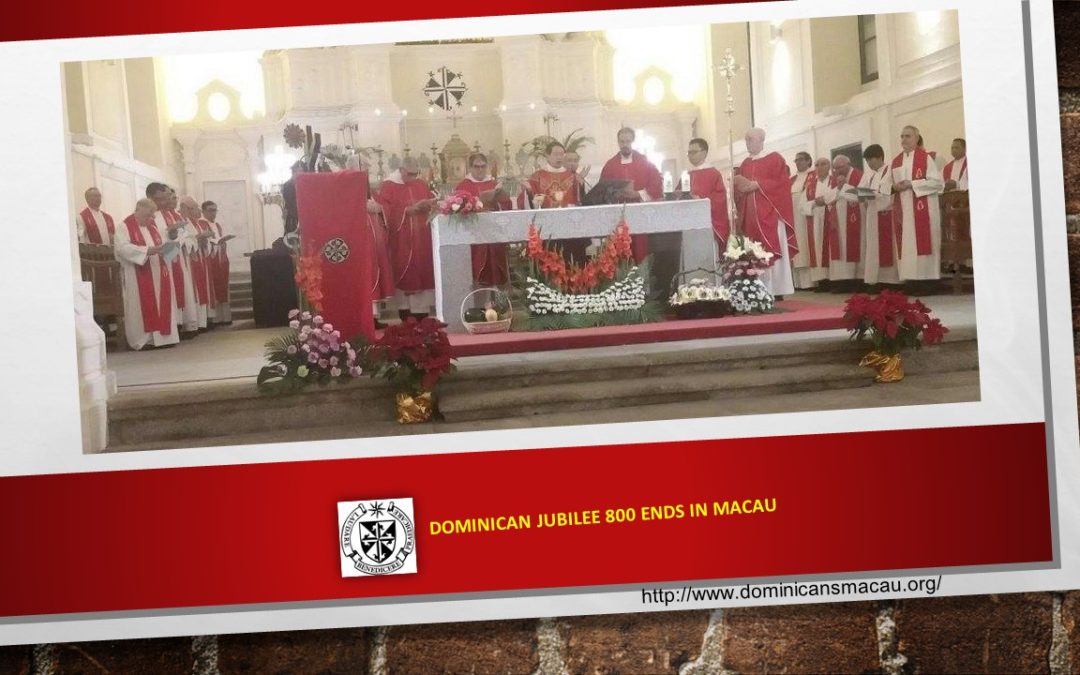
Jarvis Sy Hao, O.P.
The 800 jubilee celebrations in the Hong Kong Macau-China Area will formally end on 22 December 2016, with a Solemn Thanksgiving Mass at the historic Church of São Domingos in Macau. The Eucharistic celebration will be presided by His Excellency, Stephen Lee Bun San, Bishop of Macau as the Dominican men and women in the region will gather to celebrate, to thank God for the gift of preaching, and to beg strength from  Him, to face the new challenges ahead. At the same time, it wants to be a manifestation of gratitude of the Order to the Church in Macau for her continued support and hospitality to the brethren.
On 7 November 2015, the inauguration of the Jubilee year began the year long celebrations worldwide and at the local level.  The choice of Macau to culminate the celebrations in the region and in the Church of São Domingos, is not only to relive the fact of the many challenges faced by the founders when they came to the Far East, but also our commitment to serve the Church in the missions, specifically the Church in China which is intimately linked in the long and glorious history of the Dominican Province of Our Lady of the Rosary.
The project of Dominic de Guzmán
It should be recalled that a providential trip to Southern France enabled S. Dominic de Guzmán (1170-1221), then a Canon Regular of the Diocese of Osma (Castille), to open his horizon to contemplate the challenge of the Church in his time: the threat of heresy and error, the reform of the clergy and the need of revitalizing the Church through preaching and instruction. Though he collaborated with the preaching work with Papal legates and other clerics, in the end, he was left alone to assume the responsibility in continuing the work of preaching and reconciling sinners and heretics. Thus the idea of a religious institution fully dedicated to the work of preaching. He first organized a community of contemplative women who supported the work of the preachers through their prayers and sacrifices. This would later evolved into the contemplative nuns of the Order. Then he organized the clerics and recruited new members into his project, organizing themselves as clerics living in common and sharing the same mission of preaching. Lastly, lay persons who continue to live in their particular states of life, support and collaborate in the work of the Order. This would later become what is known as the “Lay Dominicansâ€.
On the occasion of the IV Lateran Council (1215), Dominic was able to present his project to the Pontiff, Innocent III, who though giving tacit permission for the foundation, demanded some clarifications and requirements as stipulated by the recently concluded Council.
The official written confirmation of the foundation of the Order was published by Pope Honorius III on 22 December 1216, entitled “Religiosam Vitamâ€, recognizing the establishment of Dominic and his companions as a religious Order with all the rights and privileges it shall assume. Further bulls and Papal letters published henceforth would begin to delineate the charism, specificity and mission of the “new†Order of Preachers. By the Summer of 1217, as he gathered the friars to celebrate the great Marian feast of the Assumption, he dispersed the brethren throughout Christendom, sending them to urban centers and university cities as well as locales of frontier mission. This not only facilitated the friars in the preaching ministry, but also their access to formal education and formation and seek sources for vocational recruitment. And since then, throughout eight hundred years, the Order continues to serve the Church around the world.
Â
Dominicans in Macau
The Order of Preachers arrived in Macau on 1 September, 1587; the founders were part of the first group of Friars who were tasked to found a Province in the Far East in order to evangelize the “Empire of China and surrounding kingdomsâ€.  The three founders were Castillians who came by way of México. On the basis of a donation of some properties near the Chinese bazar, the friars were able to begin conventual life and ministry on 23 October 1587, and the community was officially known as the House of Our Lady of the Rosary, the first house of the Order in Chinese soil. Due to the political climate and the animosity between Spain and Portugal, the founders were ordered to leave the enclave and sent home via Portuguese India; and in their place, the Portuguese Dominicans from India came to assume the foundation and presence till the suppression of the religious Orders in 1835. The beautiful Church of São Domingos (rebuilt few years before the suppression) stands as the mute testament of a florid presence of the friars in Macau.
Macau had to wait till the 1950’s, specifically after the “Liberation†of China, that the Dominican Missionaries of the Holy Rosary came to Macau to work in the Diocese. The sisters began their presence as housekeepers for the Diocesan Seminary and later assumed work in medical aid, education and care for orphans. They were followed by the American Maryknoll Sisters who began to assume interesting ministries in the territory a tradition they continue till this day.
At the invitation of Msgr. Domingos Lam, Bishop of Macau, the Dominican friars returned to the territory a few years prior to the handover. The brethren came to assume the work of administering the Diocesan owned “Escola São Paulo†and collaborate in some parochial ministries. By 2006, it was decided that the Students’ Community and House of Studies be established in Macau and by 2008, the House was raised into the category of a Convent. Today the Macau community is one of the biggest communities of the Province of Our Lady of the Rosary in the Far East where future missionaries are being formed.
Â
Looking forward
Despite the many challenges, the Order continues to be optimistic with the future. While various missions in the area need new blood to continue the missionary work as well as reorganization, new presences in other emerging Churches continue: in Myanmar where the Order has three communities and in the recently established presence at Timor Leste.
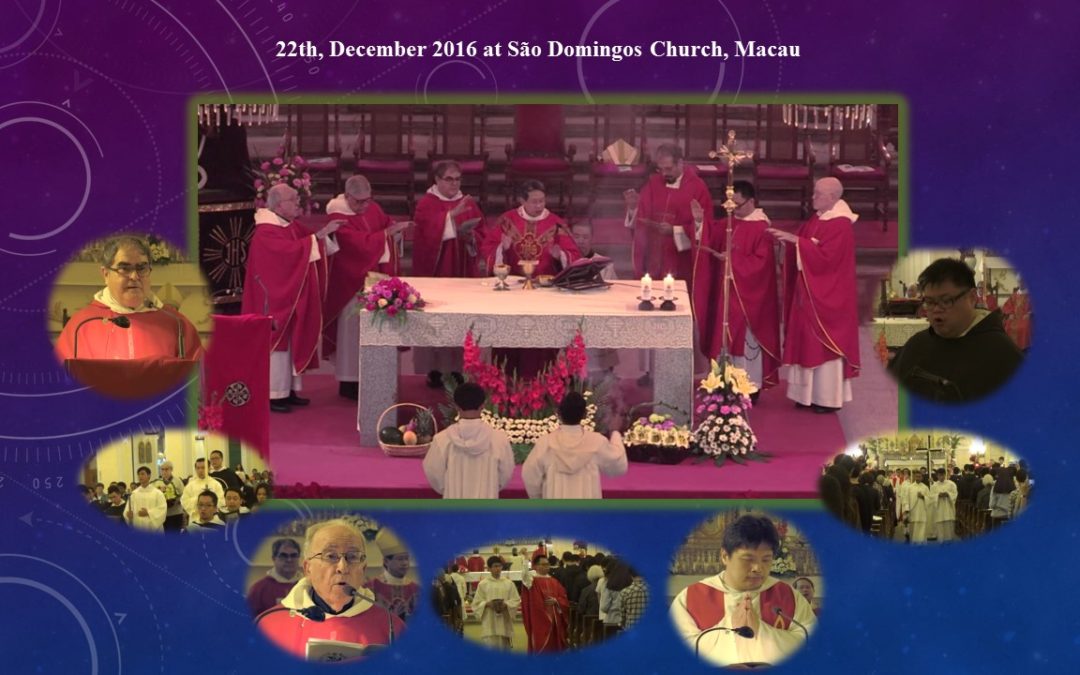
Jarvis Sy O.P.
The closing of the Jubilee celebrations for the Province of Our Lady of the Rosary took place on 22 December, 2016 at the historic São Domingos Church at the historic center of the city.
There was no other venue more appropriate for the occasion as it was the first Dominican foundation in Chinese soil, despite the fact that the foundation was short lived and was transferred to the Portuguese friars, the historic Church remains as a symbol of the Province’s undying commitment to evangelize the “ancient kingdom of China and its neighbouring kingdomsâ€, the unfinished encounter with the Chinese people, a desiderata that has perdured through centuries.
The thanksgiving mass began at 5:00 pm with Msgr. Stephen Lee Bun San, the Bishop of Macau as main celebrant, assisted by  Fr. Javier González, Prior Provincial of the Province of Our Lady of the Rosary Province, Fr. Hyacinth He Yousun, Socius of the Provincial and Prior of Saint Albert Priory, (Rosaryhill, HK), Fr. Timoteo Merino, the Master of Novices, Fr. Bonifacio GarcÃa SolÃs, ex Provincial and Syndic of the Province and Fr Manoel Machado, the Vicar General of the Macau Diocese.
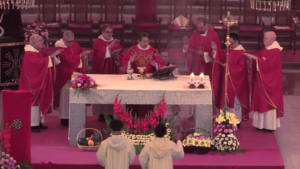
Msgr. Stephen Lee Bun San, the Bishop of Macau as main celebrant and the concelebrants
The concelebrants –the brethren from Macau and HK communities- as well as some members of the Diocesan and Religious clergy of Macau, were led in the solemn procession by the huge Dominican cross from the Priory which was carried by the novice Brother Carlos  and the Book of the Gospel by Brother Luigi. They processed through the main nave of the Church as the joint choir of the student brothers, novices, sisters and postulants began to sing the Jubilee Song of the Order.
The bishop upon approaching the altar began the incensation of the altar and the crucifix and began the liturgy. Clad in heavy red brocade, with the co-concelebrants in more somber red chasubles and stoles, (to mark the festive tone of the celebrations as well as to commemorate the witnessing of the martyrs of the Province!!!) he began to lead the Confiteor. After the recitation of the collect of the day, the assembly proceeded to the Liturgy of the Word.
The first reader was Brother Ben Lei Chi Hang OP, a Macau resident and professed student brother. He read the first reading from the book of Samuel in Cantonese. The responsorial psalm was sung by two postulants from our Sisters community: the Timorese Dionisia Salsiha Maia and the Burmese Sabina Themar whose angelic voices led the chanting of the responsorial psalm. An additional reading on the charism of preaching was read by Sister Julieta da Costa our Timorese Dominican sister working in the diocese. After the joyous singing the Gospel acclamation, Fr. Edmund Eh OP, a Singaporean friar and the Moderator of Studies/ Director of the Center of Studies read the Gospel on the Magnificat.

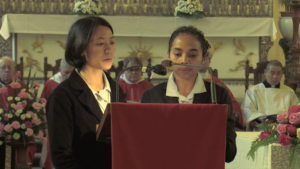
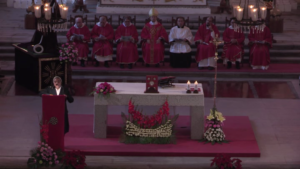
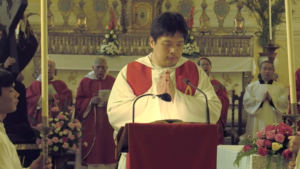
(The First Reading by Brother Ben Lei Chi Hang OP, The responsorial psalm by two postulants from our Sisters community: the Timorese Dionisia Salsiha Maia and the Burmese Sabina Themar
After the solemn reading of the Gospel, the Bishop took the ambo and preached on the figure of Mary and the role and charism of the Order; making beautiful reference on the Marian canticle.
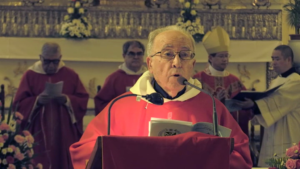
Fr. Fausto Gómez, the Subprior of Macau and     the Provincial Promoter of the Jubilee
After the homily, Fr. Fausto Gómez, the Subprior of Macau and the Provincial Promoter of the Jubilee, led the congregation for the Act of praise and thanksgiving for the gift of the Dominican vocation. This dialogued special prayer was based on the “act of praise†used during the annual Day of Consecrated Life when men and women religious reaffirm their commitment to the gospel. Four Dominicans were invited to respond: a professed student brother (Brother Joseph Tran Van Huong, a Vietnamese), a novice (Brother Christian Conlon, an Australian), a Maryknoll Sister, American, and a lay Dominican (Janet Choi). After each petition the whole assembly broke into song… After the act of praise we proceeded with the “Te Deum†as the Church reverberated with the Hymn of Holy God we praise thy name!!
Next followed the Prayer of the Faithful… there were eight intentions all in all and four persons were tasked to lead the prayers: A student brother (Brother Albert Liu, a Chinese), a novice brother (Brother Gabriel Khun Ri, a Burmese), a lay Dominican (Sister Rose Pae Alcántara- Filipina) and a woman religious (Sr. Elsamma George OP, Indian).
The next part of the liturgy was the Liturgy of the Eucharist. The offertory procession was led by the two candle bearers who led the offerers from the main door of the Church to the presbytery. The offerers were: Brother Mannes Kim (Korean) bearing the fruit basket; Sister Begoña Abad OP (Spaniard), bearing the basket of flowers; Sister Ann (American) bringing the bread and sister Marian Navarro Yip (Filipina) carrying the cruets of wine and water. They marched through the great nave as the choir sang the “Veni Veni Emmanuelâ€, in Latin.
While the proper prayers for the mass and the readings were taken from the proper liturgy of the day as it was within the Major week of Advent, the Bishop allowed us to use the Proper Preface of the Patronage of Our Lady over the Order which evoked her maternal protection and inspiration in the work of Dominic and the life of the Order.
The Eucharistic Prayer III was chosen for the concelebration and the “Pater noster†was sung in Cantonese by the grand choir with aplomb.
During communion, as the congregation processed into the nave, Brother Bosco deftly played the organ with beautiful rendition of “Jesus, the joy of man’s desireâ€, to create a moment of recollection and prayerfulness.
After communion, the assembly took up to sing King’s “Dominican Magnificat†which was sang with profound emotion by the friars.
After the post communion prayer, Fr. Provincial took the opportunity to thank those who attended and to wrap up the celebration.
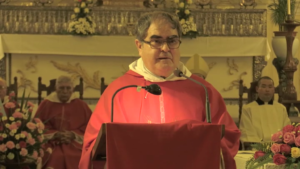
Fr. Javier González, Prior Provincial of the Province of Our Lady of   the Rosary Province
After the solemn blessing proper of the Advent season, Fr. Hyacinth He was asked to lead the solemn Salve with the chanting of the solemn tone of Salve Regina complete with candle bearers and bearer of the holy water vat. In the middle of the hymn, Fr. Hyacinth began to sprinkle holy water to the congregation.
The recessional began as the friars began to chant the antiphon “O Spem miram…†The commentator and liturgist was Fr Jarvis Sy and the conductor was the cantor mayor of the priory, Brother Abraham Ning Ki Gei.
Souvenirs were handed out to those who attended. They were a commemorative fan and a book on the life of S. Dominic. After the celebrations, the guests were brought to the Banquet Hall of Sintra Hotel where the guests were served with a buffet. It was about 8:30 when the dinner ended and those who had to return to HK on the same day left for the Ferry Terminal.
We thank the collaborative effort of all the brethren in the region, especially those of Macau for the preparations as well as the many details to make the celebration unforgettable.
The impressive presence of the friars in formation who were clad with the black and white habit filling the baroque Church was a great marvel to behold; not to mention the solemn Salve… It had been more than a century when this chant was sung by a great number of friars with such intense depth and emotion.
Â

The Dominican brothers of St. Dominic’s Priory in Macau organized an academic lecture on preaching and invited the Missionary Dominican Sisters of the Rosary, and the members of the Dominican Lay Fraternity. The speaker was Brother FelicÃsimo MartÃnez, OP, an outstanding Spanish theologian from the Dominican Province of our Lady of the Rosary, the Province of St. Dominic’s Priory in Macau. Bro. FelicÃsimo is currently a visiting professor at the Faculty of Religious Studies of the Catholic University of Saint Joseph, Macau. The session on preaching was held at the Priory’s Hall on April 1, 2017. Hereafter, we have the great pleasure of publishing the text of the lecture.
The preacher and the charismatic authority to preach:
There are many manuals on sacred oratory; little has been said about the interior of the preacher, about the spirituality and the life of the preacher. The Master of preaching is the Holy Spirit; but the formation of the preacher is necessary.
Some conditions to become a good preacher:
- The implication of the preacher in preaching
- It does not mean to preach oneself, to tell about your travelling around the world, but to pass the message through personal experience. That requires much contemplation.
The preacher is a witness involved not a mere spectator. That happens with the Cyrenean in the movie The Passion. At the beginning he is a mere spectator. Then he looks at Jesus and Jesus looks at him and he becomes a committed witness.
- Albert Magnus wrote: Teaching should not be passing ideas “ex libris in libros†(from one book to another book). Neither Preaching must be that kind or work. In that case, preaching would become mere speech and rhetoric.
- Humbert of Romans wrote: Preaching is not the same as giving sermons. Only a believer can preach. Even a non-Christian can give a sermon. A witness is not a model; he is somebody with strong conviction and strong faith.
- Preaching then implies a lot of prayer and contemplation, but also the grace of preaching, the charism, the supernatural vocation given by the Spirit.
- St. Thomas wrote: charisms are not habits, but transient passions. The preacher must be very attentive to know when to preach and when to keep silence.
- In the origins of the Order the problem was not so much to define the grace of preaching as to discern it. Some brothers like Juan de Vicenza attributed this grace to them too easily. In 1249 the expression “gratia praedicationis†was removed of the Constitutions, which did not mean that the grace of preaching was dispensed with.
- Several criteria for the discernment of the grace of preaching: the grace of preaching is not the same as being funny o amusing the audience; grace of preaching makes the preacher more humble; the grace of preaching should be discerned by the community. The preacher is not a medium and the Spirit acts respecting his character, his reason and freedom; the true grace of preaching is a source of spirituality for the preacher; one special criterion: the fruits of preaching; Grace does not act on the surface of people, but in their interiority; a good criterion: motivations and progress in humanization in the preacher.
- The experience of faith and listening to God
- The power of preaching depends on the strength of faith. Faith today is not to be taken for granted even in religious life. We are not atheistic or agnostic, but we can be short of confidence in God.
We should not confuse the experience of faith with piety, with emotion and religious emotions. In most of the conversions, illumination is more relevant than changing in morals.
- We should not confuse faith with moral stature. Not a faultless moral, but a strong faith is what really supports preaching. The preacher bears witness of what he has seen and heard.
- The experience of faith is not strange to worldly experience, to everyday life. Christian experiences should be an incarnate experience. Preaching is not only to illustrate the mystery of God, but to understand it from the human experience itself and to interpret this human experience from the mystery of God.
- Compassion and listening to humanity
- It is necessary to listen to God and to listen to humanity before preaching.
- The zeal for the salvation of souls was a special trait of Saint Dominic. He meant the salvation of the whole person and of the people already in present life. A good preacher must have passion and compassion for the world.
- Compassion obliges to hear attentively and cordially the suffering, to relate compassionately to the world. Especially in two areas: listening to the disputed issues of the present time in which the world of meaning is played; and listening to the cries of the victims.
- The study and the passion for truth
- The Master of the preacher is the Spirit. But the preacher should be prepared remotely with the study and immediately with the prayer and contemplation. Preaching is not efficient “ex opere operatoâ€.
- The motto of the Order is VERITAS. We are not owners of the Truth but we are bound to keep always searching for the truth, to feel passion for the truth. We should ask God that he might give us the instinct of truth.
- Truth is a great service to justice. As Saint Paul says in the letter to the Romans injustice itself needs to kidnap the truth in order to be justified.
- When preaching has been alive in the Dominica Family, the study has flourished and vice versa. Cardinal Cajetan, O.P. insisted on this in his intent to reform the Order.
- Today we cannot master all the sciences, but we can be attentive to the disputed issues.
- It is necessary to give priority to the study of theology, of the Bible. There are things that should not be repeated in our catechesis, in our preaching. The cancer in a person is not punishment for any sin at all.
- Study allows the preacher to place the message in the gaps of the existence of persons. Preaching means to help the people to look at the world and at life as God looks at them. Preaching is to announce God who looks at us lovingly.
- Evangelical life and humility in the preacher and in the community of preachers
- Preaching is a charism. Its effectiveness depends on the action of the Holy Spirit and on the power of the Word of God.
- The authority of the preacher is his evangelical life (not his holiness). That allows the Spirit to act through the preacher.
- Many Fathers of the Church and our Brother Luis de Granada, O.P. insisted that the Preacher should not destroy with his life what he announces with his or her words. Saint Paul repeats many times in his letters: I behave like this “So as not to discredit the ministry of the Gospel I preach†(2 Cor. 6, 3…)
- Counting on our frailty the preacher should not preach with cynicism, but with humility. It is very important for him or her to recognize his or her human and Christian limitations. Humbert of Romans, O.P. wrote: it is better to go outside to preach and with the risk of becoming stained than to be cloistered and remain pure. In the origin of the Order, we receive a Bula in which it is said: “That your preaching could be a remedy for sinsâ€. For old monks the remedy for their sin were the ascetical exercises; for the preachers the remedy is the ministry of preaching with all its inconveniences.
- The preacher must be very humble to manage the failure (sermon of the chairs). But above all he or she must be very humble to manage the success. The applause of the public is not the true measure of the effective preaching of the Gospel. Kierkegaard used to say: “I won’t evaluate the success of my preaching taking into account the applause of the audienceâ€.
- Toward the explicit announcement of the Gospel
- All is preaching. I have heard many brothers and sisters saying that. I agree. But the priority in Dominican preaching is the explicit announcement of the Gospel in the most different ways: catechesis, teaching, homily, informal conversation…
- From the Vatican II the Church has underlined the priority of evangelization: Evangelii Nuntiandi, New evangelization…
- There are two main reasons for the explicit announcement of the Gospel in today’s world: First, because it is impossible for a person to come to the Christian faith unless he or she hears the announcement of Jesus Christ. “Fides ex auditu†(Faith comes from hearing). Second, many people today are short of meaning or sense for their lives. And the Gospel is a rich source of meaning for human life.
- Certainly, we should announce the Gospel in proper time and in adequate circumstances, without proselytism. Neither we should invade the privacy and freedom of any person nor should we be inhibited preachers.
- To preach the Gospel it is very relevant to fit the most adequate tone or tune.
- To nail the message to human experience
- The purpose of preaching is not mere illustration, academic illustration. The last goal of preaching is conversion, global conversion of life. Saint Thomas wrote: The purpose of preaching is: instruction in Christian doctrine, moving interior affections, coming to love God, people and things.
- Preachers should descend from the scaffolding of reason to the stratum of the heart. They have to bring the evangelical message to the center of the person. And, according to the Bible, the center of a person is the heart with all our affections.
- In order to achieve this goal it is very important to use examples, metaphors, parables (B. Bro). All these resources were called in the Middle Ages “Exemplaâ€. There is a beautiful example in the French Dominican Fr. Bro, famous preacher in Notre Dame. His grandfather was handicapped and could not attend mass in the church. He used to tell the small boy Bernard: “You have to report to me the homily of the priestâ€. By doing that the little boy received a tip. And Bernard realizes this: If the preacher put an example or told a funny story, he could recall it and report to the grandfather and he received the tip. If the preacher spoke only about ideas, he could not remember a simple word, and could not report to the grandfather. Consequently, no tip. And so, Bernard became a very famous preacher because of his using of examples, stories….
- Conversion is a question of light, vision, illumination. This is the name for baptism in the ancient Church (Hebrews, Nicodemus, Bartimaeus… and afterwards Paul, Augustin, the great converts…). I have a good collection of stories of conversion. In all of them, the main point is illumination, new light, new vision of live. Read the story of conversion of Saint Paul (Acts 9, 1-19).
- Enlightenment must overcome the world of ideas and become wisdom. It is the work of the Spirit in the preacher and the listener.
- The main purpose of preaching is to nail the message into the gaps of human existence. Finding the connection between the Gospel and the human experience. Here is to be found the real key for success in preaching.
- It requires to be empathetic o sympathetic with the assembly, to pay empathic attention to the situations of the people, to listen carefully to their problems, real problems.
- To nail the message in human experience does not mean to confirm the expectations of listeners. Many times the Gospel questions our views, our expectations, the behavior we like most.
- Specific traits of Dominican preaching
- Preaching must be charismatic
- That means that we should reinforce our preaching, not with our hierarchy as priest or religious, or bishop, but with the strength of the Word of God, of the Spirit, or our evangelical life.
- On what authority are you preaching to us? That is the big question. It is not a matter of legal authority, but of evangelical authority.
- Dominic´s resignations to the episcopate had this purpose. It was not a mere question of personal humility. He wanted to preach the Gospel in a charismatic manner.
- Spiritual truth is to be preached by a spiritual person and by spiritual means. Humbert of Romans.
- To preach like that we need the grace of preaching. In the old times, when a brother was sent to preach, the community prayed the prayer revealed to the Cistercian of Tuscany: “Might God give to the preacher the grace of preaching and the gracious wordâ€.
- Preaching must be doctrinal
- It does not mean academic, theoretic, abstract preaching. In the Middle Ages the Dominican preaching was called doctrinal to distinguish it from moral and penitential exhortations. (You have to behave, you have to be good…)
- Doctrine here means the core of the Christian creed, rule of faith, central mysteries of Christian faith…
- Doctrinal does not mean tying orthodoxy; it is not theoretical and abstract. It refers to the central mysteries of faith (kerygmatic). It is a preaching able to break the hearts of the people, as many times happens in the Acts of the Apostles.
- This doctrinal preaching requires much prayer, much contemplation, much study…
- The Dominican Preacher must overcome moralizing preaching and reach the roots of Christian faith so that the Holy Spirit opens the doors of faith.
- Preaching must be positive and hopeful
- That means to proclaim salvation more than condemn.
- Our preaching is in the service of hope. It must help the people to look at the world with the eyes of God. And God knows the salvific potential of human history.
- Preaching must be prophetic
- Being positive and hopeful does not mean being naive and ignoring the evil in the world.
- Preaching must discern the signs of the times, distinguishing what is of grace and of sin in our world.
-  And you know very well: the Dominican Preaching must be multiform, itinerant, preaching on the frontiers…. All that is easy to say and difficult to practice.
- Â An finally our Dominican Preaching should be Preaching in Family
- This is not the Order of the friars preachers; we are the friars of the Order of Preachers.
- We have assimilated more or less the effective and emotional membership in Dominican Family. We have to assimilate the challenge of being together in mission. We need to preach together. This is the way to build up the Dominican Family.
- We need to retrieve the communitarian character of our Preaching. We need to reaffirm the common vocation of all of us in the Dominican Family, to develop common projects, to enrich our experience of the gospel.
- Preaching in Family has some advantages: to enrich our Dominican Life, to expand the ministry of Preaching, to testify practically that all of us are equal in dignity, to reinforce the democracy in the Dominican Life.
FelicÃsimo MartÃnez, O.P.
St. Dominic’s Priory
Macau April 1, 2017

